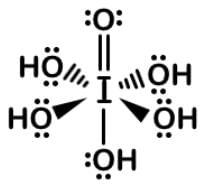MCAT Exam > MCAT Questions > Periodic acid (H5IO6) will selectively cleave...
Start Learning for Free
Periodic acid (H5IO6) will selectively cleave vicinal diols into two aldehyde or ketone fragments, which can be used to label the 3’-termini of RNA instead of DNA. Periodic acid can be dehydrated twice to form metal periodic acid. What are the molecular geometries of the two compounds respectively?
- a)octahedral and tetrahedral
- b)trigonal bipyramidal and see-saw
- c)trigonal bipyramidal and square planar
- d)hexagonal and tetrahedral
Correct answer is option 'A'. Can you explain this answer?
| FREE This question is part of | Download PDF Attempt this Test |
Most Upvoted Answer
Periodic acid (H5IO6) will selectively cleave vicinal diols into two a...
Starting with periodic acid, iodine has to be the central atom since it is the only atom that can expand its octet.
Since there are 5 hydrogens and 6 oxygens, it seems likely there are 5 hydroxyl (-OH) groups and a lone bonded oxygen. Since iodine has 7 valence electrons, it can expand its octet to form 7 bonds.
since each hydroxyl group is single bonded, then the lone oxygen has to be double bonded to form this Lewis dot structure:
since each hydroxyl group is single bonded, then the lone oxygen has to be double bonded to form this Lewis dot structure:

Since iodine could have 7 bonds, each of the 3 oxygens has to be double bonded and the 1 hydroxyl group single bonded to form this Lewis dot structure:

Periodic acid has an octahedral molecular geometry and metaperiodic acid has tetrahedral molecular geometry.
Attention MCAT Students!
To make sure you are not studying endlessly, EduRev has designed MCAT study material, with Structured Courses, Videos, & Test Series. Plus get personalized analysis, doubt solving and improvement plans to achieve a great score in MCAT.

|
Explore Courses for MCAT exam
|

|
Similar MCAT Doubts
Periodic acid (H5IO6) will selectively cleave vicinal diols into two aldehyde or ketone fragments, which can be used to label the 3’-termini of RNA instead of DNA. Periodic acid can be dehydrated twice to form metal periodic acid. What are the molecular geometries of the two compounds respectively?a)octahedral and tetrahedralb)trigonal bipyramidal and see-sawc)trigonal bipyramidal and square planard)hexagonal and tetrahedralCorrect answer is option 'A'. Can you explain this answer?
Question Description
Periodic acid (H5IO6) will selectively cleave vicinal diols into two aldehyde or ketone fragments, which can be used to label the 3’-termini of RNA instead of DNA. Periodic acid can be dehydrated twice to form metal periodic acid. What are the molecular geometries of the two compounds respectively?a)octahedral and tetrahedralb)trigonal bipyramidal and see-sawc)trigonal bipyramidal and square planard)hexagonal and tetrahedralCorrect answer is option 'A'. Can you explain this answer? for MCAT 2024 is part of MCAT preparation. The Question and answers have been prepared according to the MCAT exam syllabus. Information about Periodic acid (H5IO6) will selectively cleave vicinal diols into two aldehyde or ketone fragments, which can be used to label the 3’-termini of RNA instead of DNA. Periodic acid can be dehydrated twice to form metal periodic acid. What are the molecular geometries of the two compounds respectively?a)octahedral and tetrahedralb)trigonal bipyramidal and see-sawc)trigonal bipyramidal and square planard)hexagonal and tetrahedralCorrect answer is option 'A'. Can you explain this answer? covers all topics & solutions for MCAT 2024 Exam. Find important definitions, questions, meanings, examples, exercises and tests below for Periodic acid (H5IO6) will selectively cleave vicinal diols into two aldehyde or ketone fragments, which can be used to label the 3’-termini of RNA instead of DNA. Periodic acid can be dehydrated twice to form metal periodic acid. What are the molecular geometries of the two compounds respectively?a)octahedral and tetrahedralb)trigonal bipyramidal and see-sawc)trigonal bipyramidal and square planard)hexagonal and tetrahedralCorrect answer is option 'A'. Can you explain this answer?.
Periodic acid (H5IO6) will selectively cleave vicinal diols into two aldehyde or ketone fragments, which can be used to label the 3’-termini of RNA instead of DNA. Periodic acid can be dehydrated twice to form metal periodic acid. What are the molecular geometries of the two compounds respectively?a)octahedral and tetrahedralb)trigonal bipyramidal and see-sawc)trigonal bipyramidal and square planard)hexagonal and tetrahedralCorrect answer is option 'A'. Can you explain this answer? for MCAT 2024 is part of MCAT preparation. The Question and answers have been prepared according to the MCAT exam syllabus. Information about Periodic acid (H5IO6) will selectively cleave vicinal diols into two aldehyde or ketone fragments, which can be used to label the 3’-termini of RNA instead of DNA. Periodic acid can be dehydrated twice to form metal periodic acid. What are the molecular geometries of the two compounds respectively?a)octahedral and tetrahedralb)trigonal bipyramidal and see-sawc)trigonal bipyramidal and square planard)hexagonal and tetrahedralCorrect answer is option 'A'. Can you explain this answer? covers all topics & solutions for MCAT 2024 Exam. Find important definitions, questions, meanings, examples, exercises and tests below for Periodic acid (H5IO6) will selectively cleave vicinal diols into two aldehyde or ketone fragments, which can be used to label the 3’-termini of RNA instead of DNA. Periodic acid can be dehydrated twice to form metal periodic acid. What are the molecular geometries of the two compounds respectively?a)octahedral and tetrahedralb)trigonal bipyramidal and see-sawc)trigonal bipyramidal and square planard)hexagonal and tetrahedralCorrect answer is option 'A'. Can you explain this answer?.
Solutions for Periodic acid (H5IO6) will selectively cleave vicinal diols into two aldehyde or ketone fragments, which can be used to label the 3’-termini of RNA instead of DNA. Periodic acid can be dehydrated twice to form metal periodic acid. What are the molecular geometries of the two compounds respectively?a)octahedral and tetrahedralb)trigonal bipyramidal and see-sawc)trigonal bipyramidal and square planard)hexagonal and tetrahedralCorrect answer is option 'A'. Can you explain this answer? in English & in Hindi are available as part of our courses for MCAT.
Download more important topics, notes, lectures and mock test series for MCAT Exam by signing up for free.
Here you can find the meaning of Periodic acid (H5IO6) will selectively cleave vicinal diols into two aldehyde or ketone fragments, which can be used to label the 3’-termini of RNA instead of DNA. Periodic acid can be dehydrated twice to form metal periodic acid. What are the molecular geometries of the two compounds respectively?a)octahedral and tetrahedralb)trigonal bipyramidal and see-sawc)trigonal bipyramidal and square planard)hexagonal and tetrahedralCorrect answer is option 'A'. Can you explain this answer? defined & explained in the simplest way possible. Besides giving the explanation of
Periodic acid (H5IO6) will selectively cleave vicinal diols into two aldehyde or ketone fragments, which can be used to label the 3’-termini of RNA instead of DNA. Periodic acid can be dehydrated twice to form metal periodic acid. What are the molecular geometries of the two compounds respectively?a)octahedral and tetrahedralb)trigonal bipyramidal and see-sawc)trigonal bipyramidal and square planard)hexagonal and tetrahedralCorrect answer is option 'A'. Can you explain this answer?, a detailed solution for Periodic acid (H5IO6) will selectively cleave vicinal diols into two aldehyde or ketone fragments, which can be used to label the 3’-termini of RNA instead of DNA. Periodic acid can be dehydrated twice to form metal periodic acid. What are the molecular geometries of the two compounds respectively?a)octahedral and tetrahedralb)trigonal bipyramidal and see-sawc)trigonal bipyramidal and square planard)hexagonal and tetrahedralCorrect answer is option 'A'. Can you explain this answer? has been provided alongside types of Periodic acid (H5IO6) will selectively cleave vicinal diols into two aldehyde or ketone fragments, which can be used to label the 3’-termini of RNA instead of DNA. Periodic acid can be dehydrated twice to form metal periodic acid. What are the molecular geometries of the two compounds respectively?a)octahedral and tetrahedralb)trigonal bipyramidal and see-sawc)trigonal bipyramidal and square planard)hexagonal and tetrahedralCorrect answer is option 'A'. Can you explain this answer? theory, EduRev gives you an
ample number of questions to practice Periodic acid (H5IO6) will selectively cleave vicinal diols into two aldehyde or ketone fragments, which can be used to label the 3’-termini of RNA instead of DNA. Periodic acid can be dehydrated twice to form metal periodic acid. What are the molecular geometries of the two compounds respectively?a)octahedral and tetrahedralb)trigonal bipyramidal and see-sawc)trigonal bipyramidal and square planard)hexagonal and tetrahedralCorrect answer is option 'A'. Can you explain this answer? tests, examples and also practice MCAT tests.

|
Explore Courses for MCAT exam
|

|
Signup for Free!
Signup to see your scores go up within 7 days! Learn & Practice with 1000+ FREE Notes, Videos & Tests.
























